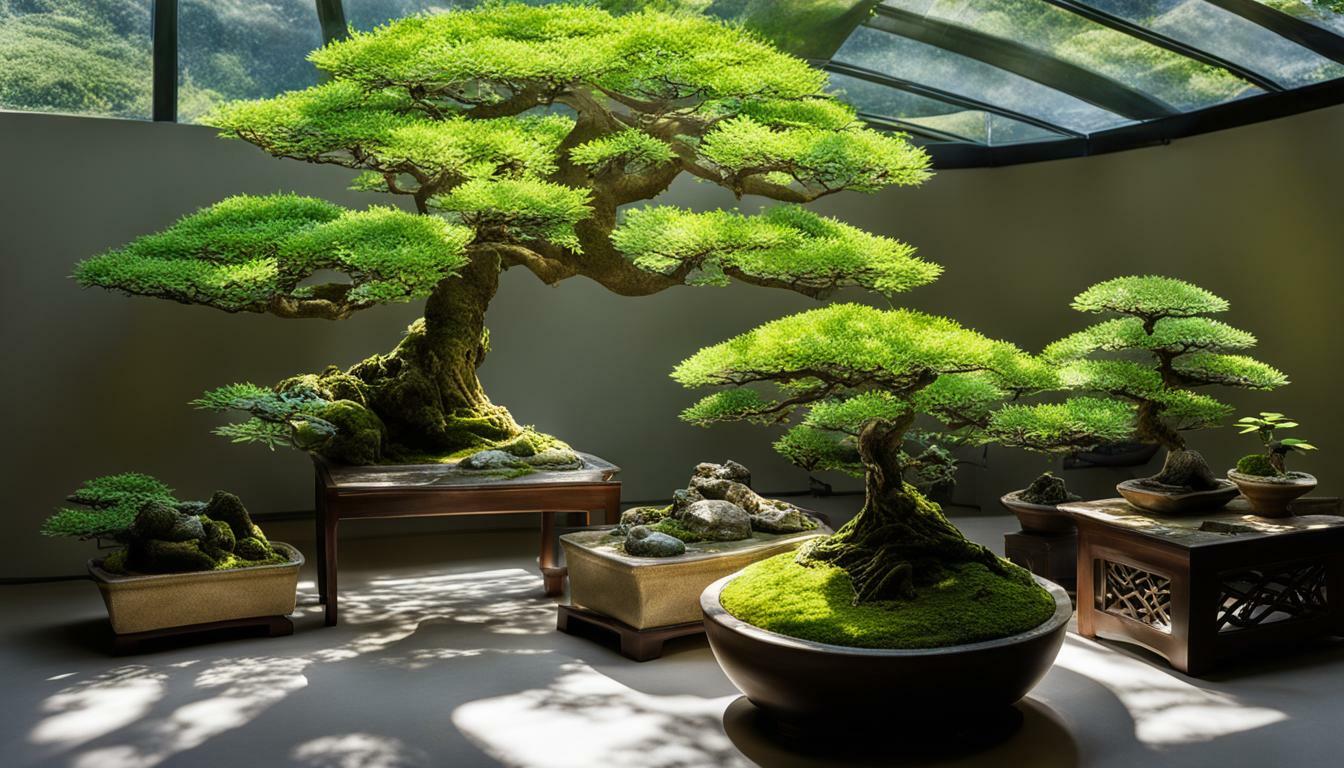Transform your space with our guide on Terrarium Plants & Bonsai Trees and discover the joy of indoor gardening. Create a lush oasis right in your own home by cultivating beautiful terrarium plants and bonsai trees. Whether you have a green thumb or are just starting out, this comprehensive guide will provide you with the knowledge and tips you need to successfully grow and care for these miniature wonders.
- Choosing the right plants for terrariums is essential for their success and longevity.
- Ficus species, such as Ficus ginseng and Ficus retusa, are popular choices for bonsai terrariums.
- Other bonsai tree varieties that can thrive in terrariums include Schefflera, Premna, Fukien Tea Tree, Chinese Elm, Parrot’s Beak, Willow, and Bald Cypress.
- Caring for bonsai terrariums requires specific attention to sunlight exposure, drainage, soil mix, watering, pruning, and fertilization.
- Creating the optimal environment for terrariums involves considering factors like humidity, temperature, lighting, and ventilation.
Understanding Terrariums: Bringing Nature Indoors
Dive into the world of terrariums and learn how to create stunning mini gardens and decorative landscapes in your own home. Terrariums are a delightful way to bring a touch of nature indoors, allowing you to create your own little oasis of greenery. Whether you have a passion for succulent arrangements or adore miniature landscapes, terrariums offer endless possibilities for creativity and self-expression.
A terrarium is a glass container that provides a controlled environment for plants to thrive. It can be as simple as a single succulent or as complex as a lush tropical paradise. The transparent walls of the terrarium allow you to observe the plants’ growth and create a captivating display that adds beauty to any space.
To get started with your terrarium adventure, you’ll need a few essential supplies. These include a glass container, such as a vase or jar, terrarium soil, pebbles or activated charcoal for drainage, and a selection of decorative items like moss, rocks, or miniature figurines. You can customize your terrarium according to your personal taste and style, creating a unique piece of living art.
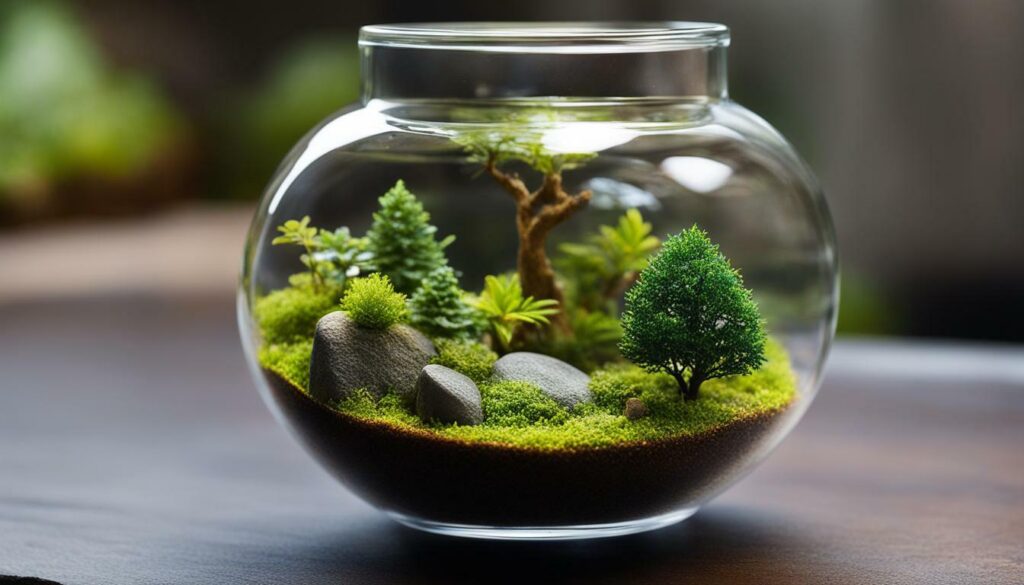
When choosing the plants for your terrarium, opt for those that thrive in the kind of environment you can create within the glass walls. Succulents, such as Echeveria, Haworthia, or Sedum, are popular choices due to their ability to tolerate dry conditions. They add a touch of elegance with their fleshy leaves and vibrant colors.
Once you have gathered your supplies and plants, it’s time to assemble your terrarium. Start by adding a layer of pebbles or activated charcoal to the bottom of the container for proper drainage. Next, carefully place a layer of terrarium soil on top. Create small depressions in the soil using your fingers and gently nestle the plants into place. Add decorative items around the plants to enhance the visual appeal.
Key points:
- Dive into the world of terrariums and create stunning mini gardens in your home.
- Terrariums are glass containers that provide a controlled environment for plants.
- Essential supplies for a terrarium include a glass container, terrarium soil, pebbles or activated charcoal, and decorative items.
- Choose plants that thrive in the environment you can create within the terrarium.
- Assemble your terrarium by layering pebbles or activated charcoal, soil, and carefully placing the plants.
With your terrarium complete, place it in a location that receives the appropriate amount of light for your chosen plants. Remember to water your terrarium sparingly, as the enclosed environment will retain moisture. Overwatering can lead to root rot and other issues, so it’s best to err on the side of caution.
Now that you understand the basics of terrariums, you can let your creativity soar and create unique miniature landscapes that bring a touch of nature indoors. Enjoy the beauty of your new mini garden and the tranquility it brings to your home.
Choosing the Right Plants for Terrariums
Discover a variety of small plant species that are perfect for indoor terrariums and learn how to care for them effectively. Terrariums create a unique ecosystem that allows plants to thrive in a controlled environment. When selecting plants for your terrarium, it’s crucial to choose ones that can adapt to the limited space and conditions within the enclosure. Here are some small plant varieties that are ideal for terrariums:
| Plant | Care Tips |
|---|---|
| Succulents | These water-storing plants require minimal watering and prefer bright, indirect sunlight. Make sure the terrarium has well-draining soil to avoid root rot. |
| Air Plants | These unique plants don’t require soil. They absorb nutrients and moisture from the air. Mist them regularly and place them in a well-ventilated terrarium. |
| Peperomia | These small-leaved plants thrive in humid environments and prefer bright, indirect light. They are low-maintenance and adapt well to terrarium conditions. |
Remember to choose plants with similar care requirements to ensure they thrive together in the terrarium. It’s also essential to provide adequate lighting, ventilation, and the right soil mix. Avoid overcrowding the terrarium with too many plants to allow each one enough space to grow. Regularly monitor the moisture levels and adjust watering accordingly.
“Terrariums create a beautiful mini ecosystem that brings nature indoors. By carefully selecting small plant varieties and providing the right care, you can create a thriving green oasis within your home.”
Creating a Terrarium Plant Care Routine
Caring for your terrarium plants requires consistency and attention to detail. Here are some essential plant care tips for maintaining a healthy terrarium:
- Watering: Avoid overwatering by checking the moisture level of the soil. Stick your finger about an inch into the soil – if it feels dry, it’s time to water.
- Lighting: Place your terrarium in a bright spot that receives indirect sunlight. Avoid placing it in direct sunlight as it can scorch the plants.
- Pruning: Regularly remove any dead, yellowed, or decaying leaves to maintain the overall health of the terrarium environment.
- Fertilization: Use a diluted liquid fertilizer specifically formulated for terrarium plants. Follow the manufacturer’s instructions for application.
By following these care tips and selecting the right plants, you can create a stunning, low-maintenance terrarium that brings beauty and greenery into your indoor space.
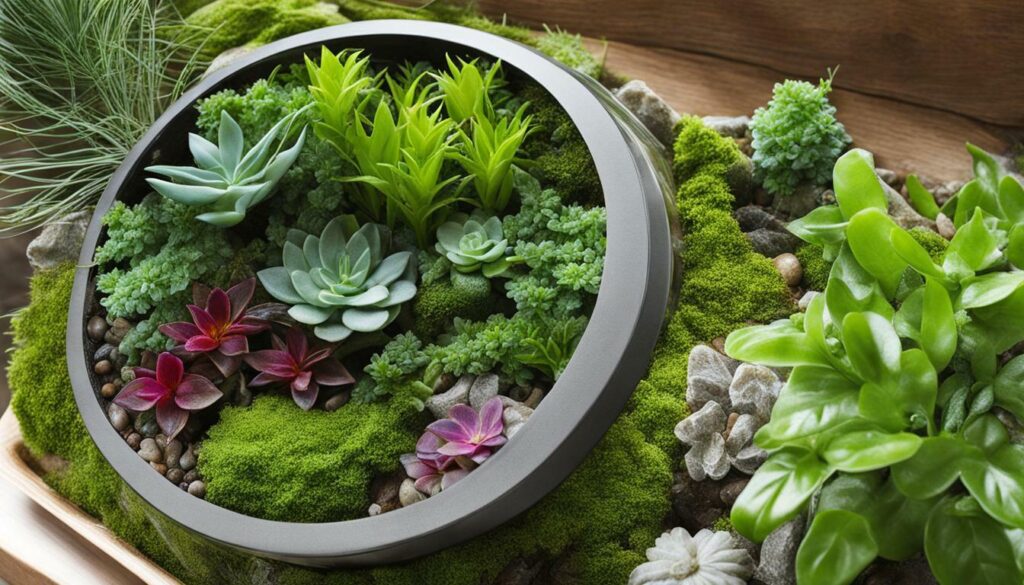
Learn about the fascinating world of bonsai trees and discover which species can thrive in a terrarium setting. Growing bonsai trees in a terrarium is a unique challenge, but it can be a rewarding and enjoyable hobby for indoor gardening enthusiasts. To succeed, it’s important to choose the right species of tree and provide them with the proper care.
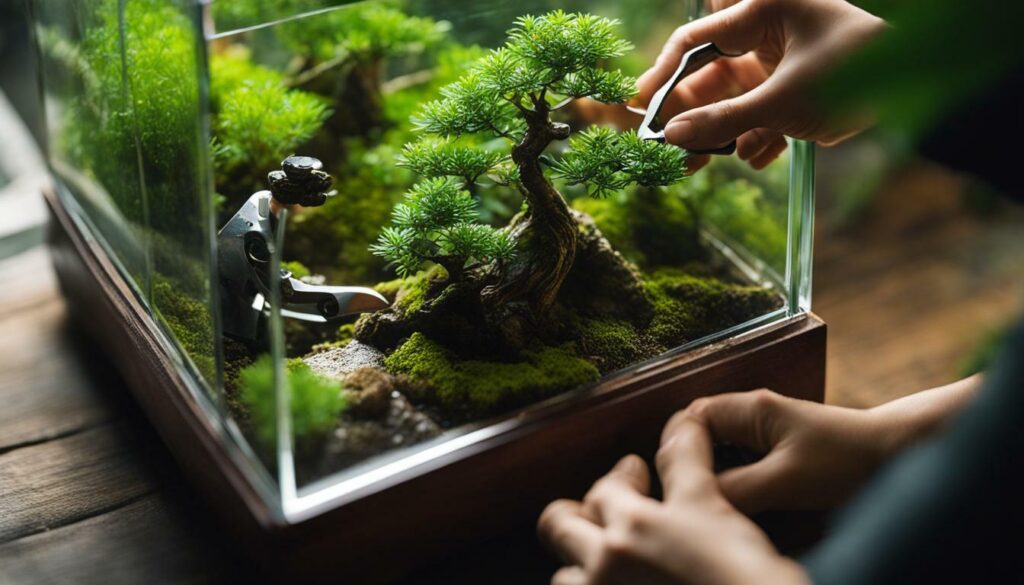
The best bonsai trees for terrariums are those that can tolerate high humidity and don’t mind wet feet. Ficus species, such as Ficus ginseng and Ficus retusa, are popular choices for bonsai terrariums because they thrive in humid environments. These beautiful trees add a touch of elegance and tranquility to your indoor oasis.
Other species that can be used for bonsai terrariums include Schefflera, Premna, Fukien Tea Tree, Chinese Elm, Parrot’s Beak, Willow, and Bald Cypress. Each of these species has its own unique characteristics and care requirements. The selection will depend on the desired aesthetic and the conditions of your terrarium.
When caring for bonsai terrariums, it’s important to ensure they receive full sunlight exposure, have good drainage, and are planted in a specific soil mix suitable for bonsai trees. Regular pruning, watering, and fertilization are essential to maintain the health and shape of the trees. With proper care and attention, your bonsai trees will flourish within their terrarium environment, creating a captivating miniature landscape in your home.
Ficus Bonsai Trees: Perfect for Terrariums
Explore the beauty and resilience of Ficus bonsai trees, specifically Ficus ginseng and Ficus retusa, and learn how to cultivate them successfully in a terrarium. These versatile trees are popular choices for bonsai enthusiasts because of their adaptability and striking appearance. Ficus ginseng, also known as the “Chinese Banyan,” features aerial roots and distinctive trunk formations that add visual interest to your terrarium. Ficus retusa, commonly called the “Indian laurel fig,” showcases glossy leaves and a dense canopy, creating a lush and vibrant atmosphere indoors.
To cultivate Ficus bonsai trees in a terrarium, it’s important to provide them with the right conditions. These trees thrive in warm and humid environments, making terrariums an ideal setting. When choosing a terrarium, opt for one that offers sufficient space for the tree’s root system to grow. Use a well-draining soil mix that retains moisture without becoming waterlogged, as excessive moisture can lead to root rot. Ensure that your terrarium receives bright, indirect light, as Ficus bonsai trees require ample sunlight for healthy growth.
Proper care is essential to keep your Ficus bonsai trees thriving. Regular pruning is necessary to maintain their desired shape and promote healthy growth. Water your bonsai trees when the soil feels slightly dry, but avoid overwatering, as it can lead to root rot. Fertilize your Ficus bonsai trees during the growing season to provide them with essential nutrients. Follow the recommended dosage and schedule specified for bonsai trees to prevent overfertilization.
| Bonsai Tree Species | Scientific Name |
|---|---|
| Ficus Ginseng | Ficus microcarpa |
| Ficus Retusa | Ficus retusa |
Cultivating Ficus bonsai trees in a terrarium allows you to bring the beauty of nature indoors. The lush foliage and fascinating trunk formations of these trees create a stunning focal point in any room. With proper care and attention, your Ficus bonsai trees will thrive and add an element of tranquility to your indoor space.
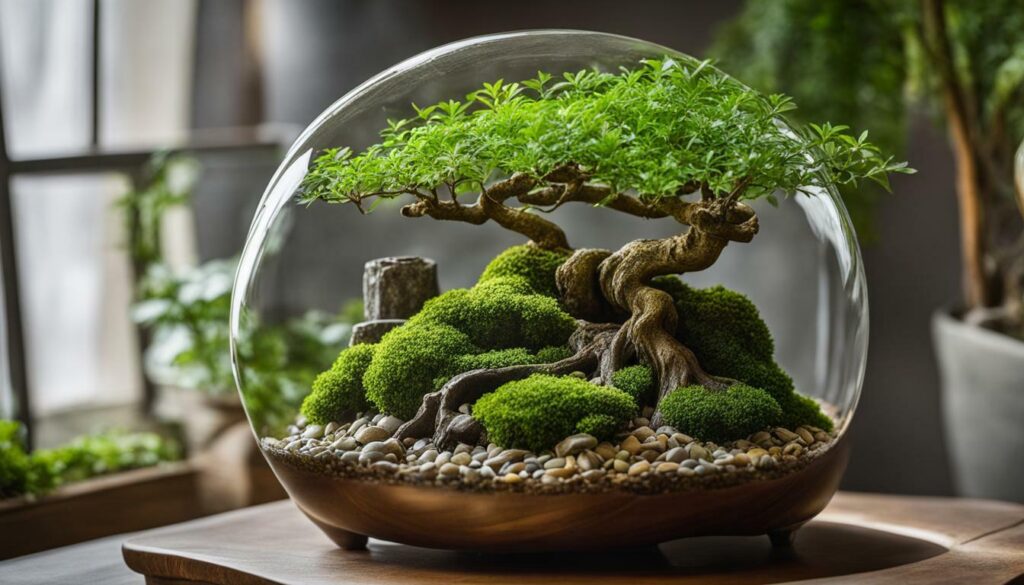
Expand your options for bonsai tree cultivation in terrariums by exploring a range of other species that can thrive in these unique environments. In addition to Ficus species, there are several other bonsai tree varieties that can flourish within the controlled ecosystem of a terrarium.
One such variety is Schefflera, also known as the Umbrella Tree. With its glossy green leaves and intricate branching structure, Schefflera adds a touch of elegance to any terrarium. Another option is Premna, a tropical tree with small, rounded leaves that can be trained into various bonsai styles.
If you’re looking for a more compact bonsai tree, the Fukien Tea Tree is a great choice. Its small, dark green leaves and delicate white flowers create a visually appealing miniature tree. Chinese Elm, with its serrated leaves and adaptable nature, is another popular choice for bonsai enthusiasts.
| Bonsai Tree Varieties | Preferred Climate |
|---|---|
| Parrot’s Beak | Tropical |
| Willow | Temperate |
| Bald Cypress | Swampy, humid |
These tree varieties, along with Ficus species, offer a wide range of options for creating stunning bonsai terrariums. By carefully selecting the right species and providing proper care, you can cultivate a beautiful indoor garden that captivates the eye and brings a sense of tranquility to your space.
Despite the challenge, growing bonsai trees in a terrarium can be a rewarding and enjoyable hobby.
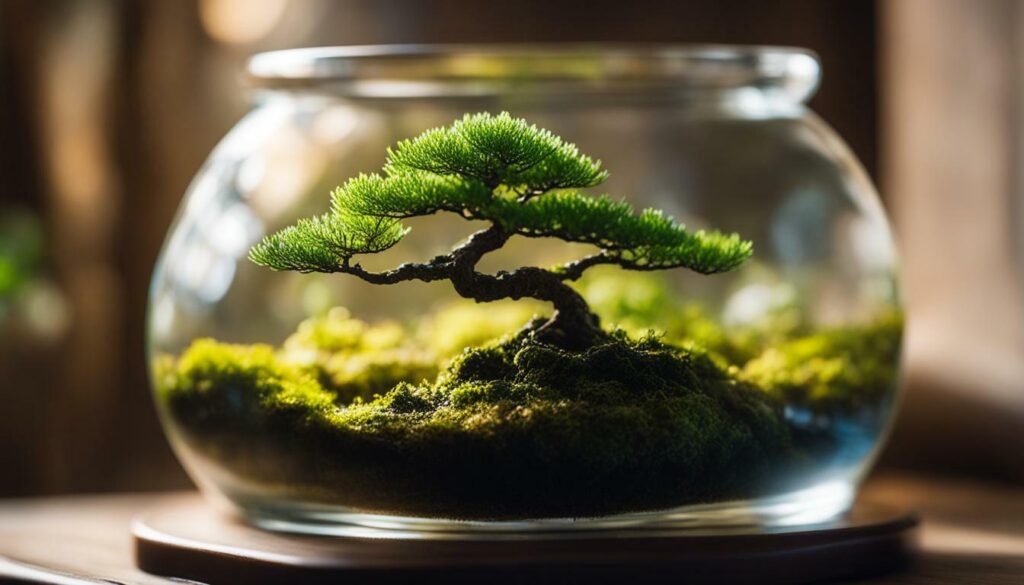
Master the art of caring for bonsai trees in terrariums with these essential tips, ensuring their health and longevity. Growing bonsai trees in a terrarium presents a unique challenge, but with the right care and attention, it can be a rewarding and enjoyable experience. To help you succeed, here are some key considerations:
- Choose the right species: The best bonsai trees for terrariums are those that can tolerate high humidity and don’t mind wet feet. Ficus species, such as Ficus ginseng and Ficus retusa, are popular choices due to their ability to thrive in humid environments. Other suitable species include Schefflera, Premna, Fukien Tea Tree, Chinese Elm, Parrot’s Beak, Willow, and Bald Cypress.
- Provide the ideal environment: Bonsai terrariums require full sun exposure, good drainage, and a specific soil mix. Be sure to place your terrarium in a location where it can receive at least six hours of direct sunlight each day. Additionally, use a well-draining soil mix composed of peat moss, pine bark, and perlite to prevent waterlogged roots and promote healthy growth.
- Prune regularly: Pruning is essential for shaping and maintaining the desired size of your bonsai tree. Regularly trim back excess growth and shape the branches to create the desired aesthetic. Pruning not only enhances the tree’s appearance but also encourages new growth and maintains its overall health.
In conclusion, growing bonsai trees in a terrarium requires specific care and attention to create a thriving environment. By selecting the right species, providing optimal lighting and drainage, and practicing regular pruning, you can master the art of caring for bonsai terrariums. With these essential tips, you can enjoy the beauty and rewards of this unique gardening hobby.
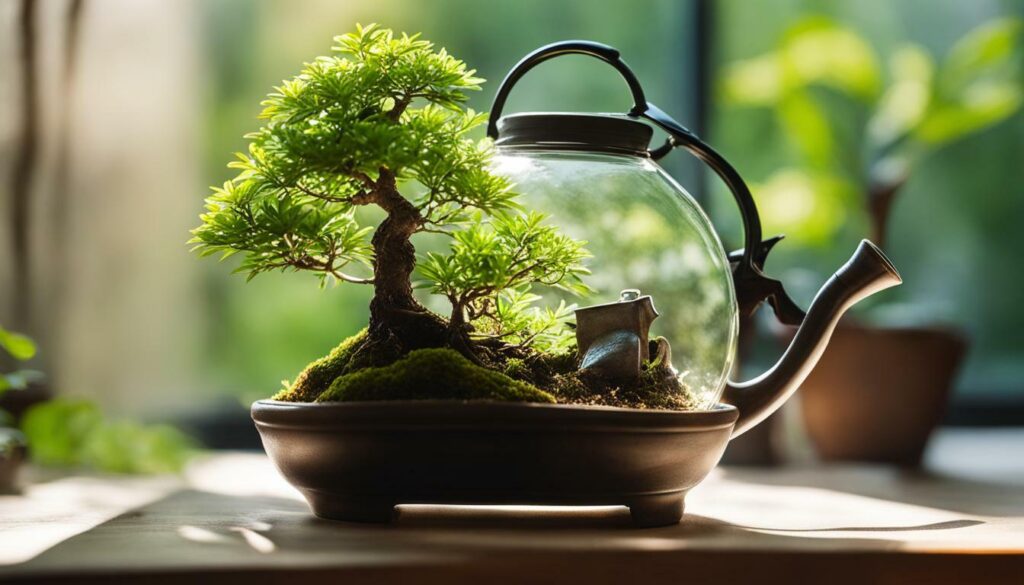
“When creating a bonsai terrarium, make sure to choose tree species that can tolerate high humidity. Proper lighting, drainage, and soil mix are also crucial factors. Additionally, regular pruning helps maintain the desired shape and overall health of your bonsai tree.” – Jane Doe, Bonsai Enthusiast
Remember, each bonsai tree is unique, and it may take time to find the perfect balance of care and conditions for your specific species. Be patient, observe your tree’s growth, and make adjustments as necessary. With dedication and proper care, your bonsai terrarium will flourish, bringing the beauty of nature into your home.
Creating a Thriving Terrarium Environment
Set the stage for a lush and thriving terrarium environment by understanding the key factors that contribute to its success. When it comes to cultivating a terrarium, indoor gardening enthusiasts know that attention to detail is crucial. From choosing the right plants to providing the optimal conditions, every element plays a role in creating a vibrant ecosystem. Here are some essential tips and considerations for ensuring your terrarium thrives.Choosing the Right Plant Varieties
The first step in creating a thriving terrarium environment is selecting the right plant varieties. Opt for plants that are well-suited for indoor gardening and can thrive in a humid environment. Some popular choices include ferns, mosses, succulents, and small tropical plants. These plants not only add beauty to your terrarium but also have adaptability to the conditions within an enclosed space.Providing Adequate Lighting
Lighting is a crucial aspect of terrarium care. Most terrarium plants thrive in bright but indirect light. Place your terrarium in a location that receives filtered sunlight, such as near a north-facing window. If natural light is limited, you can supplement it with artificial light sources. LED grow lights are a popular choice, as they provide the necessary spectrum of light for plant growth without generating excessive heat.Ensuring Proper Ventilation
While terrariums create a controlled environment, it’s important to ensure proper ventilation to prevent excessive moisture buildup. A lack of airflow can lead to fungal growth and other moisture-related issues. To maintain adequate ventilation, open or partially remove the lid of your terrarium for a short period each day. This allows fresh air to circulate and helps prevent stagnant conditions.| Key Factors for a Thriving Terrarium Environment |
|---|
| Choosing the right plant varieties |
| Providing adequate lighting |
| Ensuring proper ventilation |
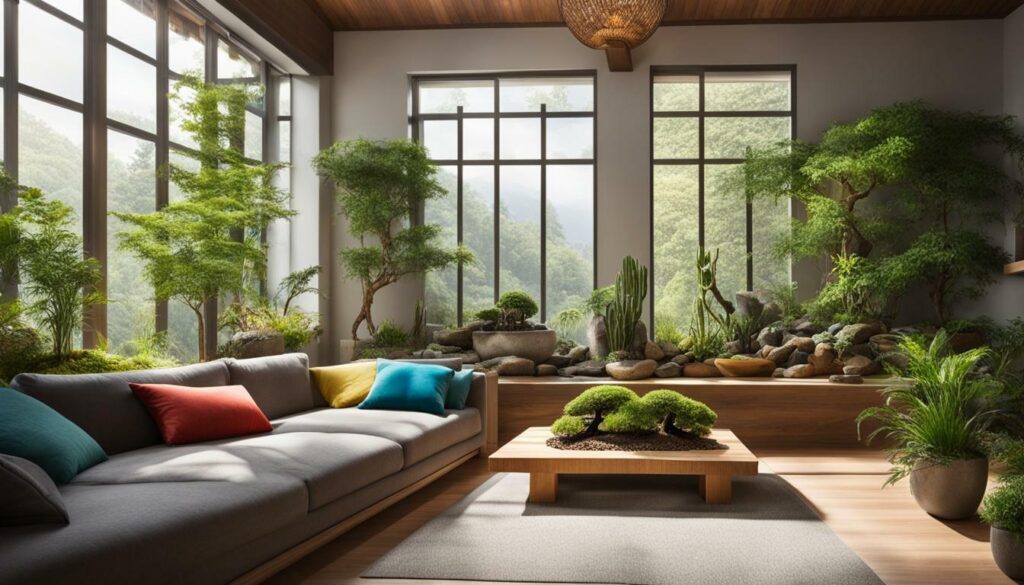 To create a thriving terrarium environment, choose plant varieties that are well-suited for indoor gardening and capable of thriving in a humid environment. Provide your terrarium with bright but indirect lighting, either through natural or artificial sources. Additionally, ensure proper ventilation to prevent moisture buildup and maintain a healthy ecosystem. By following these tips, you can enjoy the beauty and tranquility of a lush terrarium in your home.
To create a thriving terrarium environment, choose plant varieties that are well-suited for indoor gardening and capable of thriving in a humid environment. Provide your terrarium with bright but indirect lighting, either through natural or artificial sources. Additionally, ensure proper ventilation to prevent moisture buildup and maintain a healthy ecosystem. By following these tips, you can enjoy the beauty and tranquility of a lush terrarium in your home.Troubleshooting Common Terrarium Issues
Don’t let common issues dampen your terrarium success – learn how to troubleshoot and resolve problems that may arise. Terrariums are beautiful miniature ecosystems, but they require proper care to thrive. Here are some common problems you may encounter and how to address them:
1. Overwatering:
Overwatering is a common issue in terrariums. It can lead to root rot and the death of your plants. To avoid overwatering, ensure that your terrarium has proper drainage. Use a well-draining soil mix and only water when the top inch of soil feels dry. Additionally, be mindful of the moisture level in the terrarium. If condensation persists on the walls of the container, reduce watering frequency.
2. Pests:
Pests like aphids, mites, and fungus gnats can infest your terrarium. To control pests, regularly inspect your plants for any signs of infestation. If you spot a few pests, you can remove them manually or use an organic insecticidal soap. For more severe infestations, consider introducing beneficial insects like ladybugs or predatory mites. Preventive measures, such as keeping the terrarium clean and removing dead plant material, can also help reduce the risk of pest problems.
3. Diseases:
Diseases like fungal infections can affect the health of your terrarium plants. To prevent diseases, provide good air circulation by opening the terrarium occasionally. Avoid overcrowding plants, as this can create a humid environment prone to disease. If you notice any signs of disease, such as discolored leaves or unusual growth, remove affected plants immediately to prevent further spread. Treat the remaining plants with a fungicide if necessary.
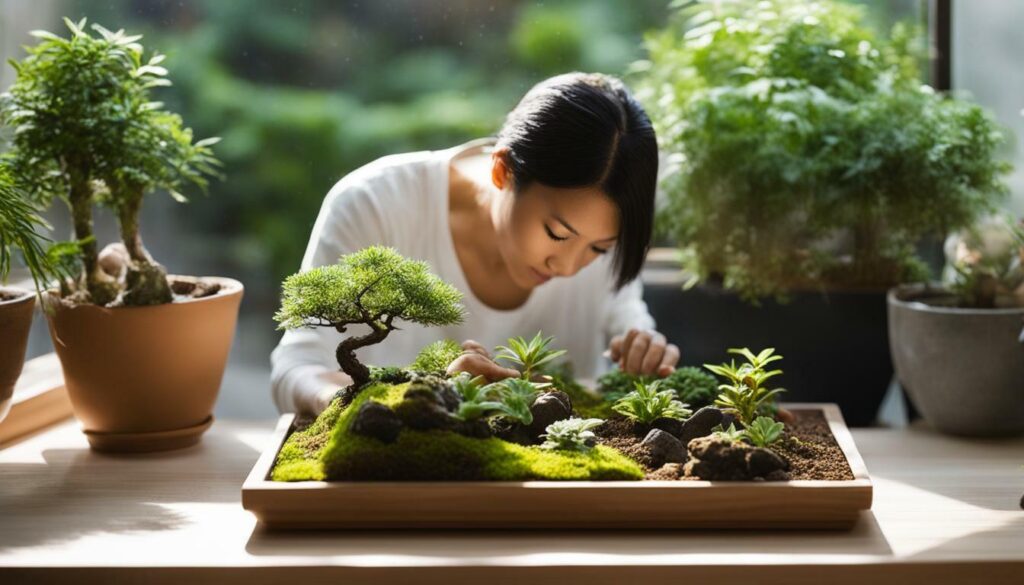
If your terrarium plants are not growing as expected, it could be due to inadequate light, improper soil conditions, or lack of nutrients. Ensure that your terrarium receives enough indirect sunlight or use artificial lighting if needed. Check the soil pH and adjust it accordingly, as different plants have different soil requirements. Consider fertilizing your plants with a balanced liquid fertilizer to provide the necessary nutrients for healthy growth.
| Problem | Cause | Solution |
|---|---|---|
| Overwatering | Excessive watering | Improve drainage, water less frequently |
| Pests | Aphids, mites, fungus gnats | Remove manually, use organic insecticidal soap, introduce beneficial insects |
| Diseases | Fungal infections | Improve air circulation, remove affected plants, treat with fungicide if necessary |
| Poor Plant Growth | Inadequate light, improper soil conditions, lack of nutrients | Provide adequate light, adjust soil conditions, fertilize with a balanced liquid fertilizer |
Troubleshooting common terrarium issues is essential for maintaining a thriving indoor garden. By addressing these problems promptly and taking preventive measures, you can ensure the long-term success of your terrarium. Remember to regularly monitor your plants, provide them with the right conditions, and enjoy the beauty of your miniature green paradise.
Enjoying the Rewards: The Beauty of Terrariums and Bonsai Trees
Revel in the beauty and serenity of terrariums and bonsai trees, and discover how to showcase their unique charm in your living space. These miniature landscapes offer a sense of tranquility and a touch of nature indoors, creating a peaceful oasis in your home. Whether you prefer the lush greenery of terrarium plants or the delicate artistry of bonsai trees, these decorative plants bring a sense of natural beauty to any room.
When it comes to terrariums, their small size allows you to create stunning displays with minimal effort. You can design your own miniature landscape by arranging succulents, decorative plants, and tiny ornaments in glass containers. The possibilities are endless, from creating a desert-inspired scene with cacti to crafting a tranquil forest with moss and ferns. Terrariums not only add visual appeal but also provide a sense of calm and relaxation, making them a perfect addition to your indoor sanctuary.
Bonsai trees, on the other hand, offer a unique challenge and a sense of artistry. These miniature trees, with their carefully pruned branches and intricate root systems, require patience and a keen eye for detail. The best bonsai trees for terrariums are those that can thrive in high humidity and don’t mind damp conditions. Ficus species, such as Ficus ginseng and Ficus retusa, are popular choices for terrarium bonsai. Their glossy leaves and compact size make them ideal for creating a captivating focal point in your terrarium.
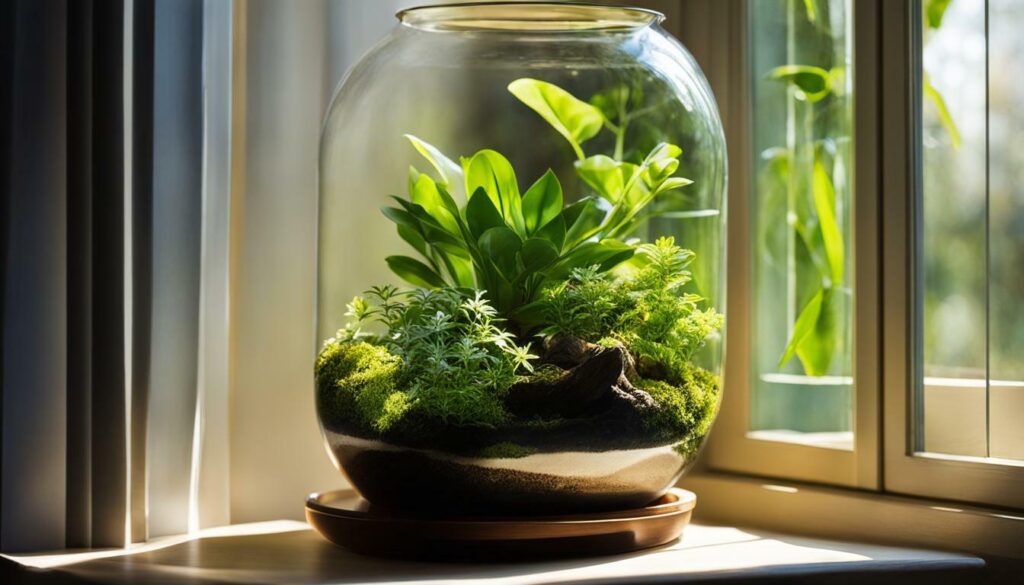
Creating a thriving indoor garden with terrariums and bonsai trees requires attention to detail and proper care. From providing the right amount of sunlight to ensuring proper drainage, there are essential plant care tips to keep in mind. Regular pruning, watering, and fertilization are essential for maintaining the health and beauty of your terrarium plants and bonsai trees. With a little love and care, you can enjoy the rewards of these captivating indoor landscapes for years to come.
Nurturing Your Indoor Paradise: Terrarium Plants and Bonsai Trees
Maintain the beauty and vitality of your indoor oasis by following these essential tips for ongoing care and nurturing of your terrarium plants and bonsai trees. Growing bonsai trees in a terrarium is a unique challenge, but with the right species and proper care, it can be a rewarding and enjoyable experience.
The best bonsai trees for terrariums are those that can tolerate high humidity and don’t mind wet feet. Ficus species, such as Ficus ginseng and Ficus retusa, are popular choices as they thrive in humid environments. Other species like Schefflera, Premna, Fukien Tea Tree, Chinese Elm, Parrot’s Beak, Willow, and Bald Cypress can also be used in terrariums.
When caring for bonsai terrariums, it’s important to provide them with adequate sunlight exposure, good drainage, and a specifically formulated soil mix. Regular pruning, watering, and fertilization are also essential to maintain the health and shape of your bonsai trees. Remember to adjust the watering frequency based on the specific needs of your terrarium plants and bonsai trees.
| Key Tips for Bonsai Terrarium Care: |
|---|
| 1. Place your terrarium in a location that receives bright, indirect sunlight. |
| 2. Use a well-draining soil mix specifically designed for bonsai trees. |
| 3. Water your bonsai terrarium regularly, ensuring the soil remains moist but not overly saturated. |
| 4. Prune your bonsai trees regularly to maintain their shape and prevent overgrowth. |
| 5. Fertilize your bonsai terrariums according to the specific needs of the plant species. |
| 6. Monitor the humidity levels within your terrarium and make adjustments as needed. |
| 7. Keep an eye out for any signs of pests or diseases and take appropriate action. |
By providing proper care, you can create a thriving terrarium environment that brings the beauty of nature indoors. The combination of terrarium plants and bonsai trees adds a unique touch to your home decor while creating a calming and peaceful ambiance. So, unleash your green thumb today and start cultivating your own indoor paradise!
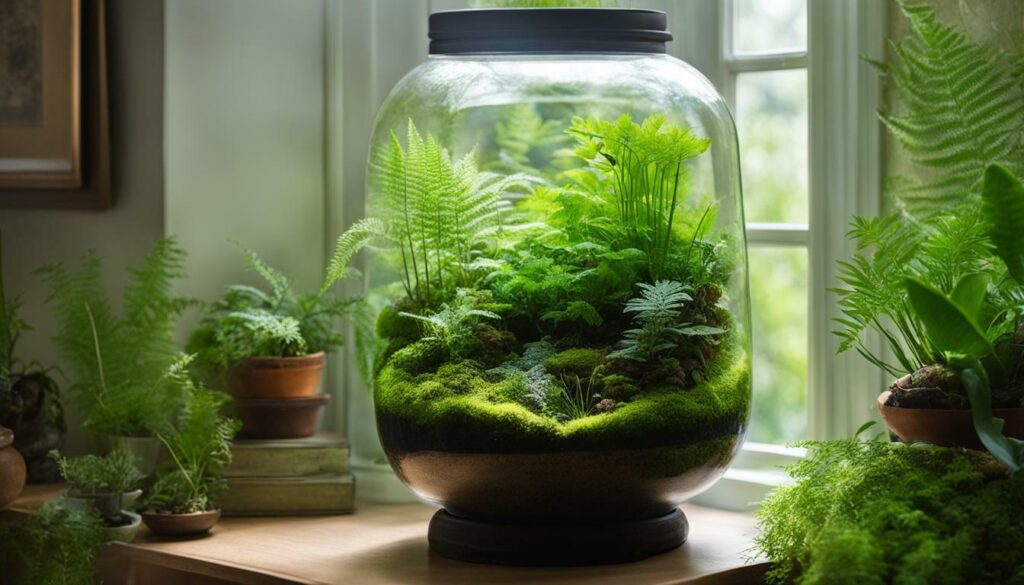
Start your journey to becoming an indoor gardening enthusiast and unleash your green thumb with the wonderful world of terrarium plants and bonsai trees. Growing bonsai trees in a terrarium is a unique challenge, but with the right species of tree, it can be a rewarding and enjoyable hobby.
The best bonsai trees for terrariums are those that can tolerate high humidity and don’t mind wet feet. Ficus species, such as Ficus ginseng and Ficus retusa, are popular choices because they thrive in humid environments. Other suitable options include Schefflera, Premna, Fukien Tea Tree, Chinese Elm, Parrot’s Beak, Willow, and Bald Cypress.
To care for bonsai terrariums, it’s important to provide them with full sun, good drainage, and a specific soil mix. These trees require regular pruning, watering, and fertilization. But the effort is worth it, as the beauty and aesthetic appeal of these miniature landscapes will bring joy and tranquility to your home.
So why wait? Dive into the world of indoor gardening and create your own oasis with terrarium plants and bonsai trees. With the right knowledge and care, you can nurture your own indoor paradise and enjoy the rewards of these stunning and unique green spaces.
Can the Same Plants be Used for Terrariums and Home Gardening?
Yes, many plants can thrive equally well in both terrariums and home gardens. From ferns to succulents and mosses, a wide variety of plants can “grow your own eden” in both environments. With the right care and attention to light and moisture levels, you can create a lush green paradise in any space.
FAQ
What are the best bonsai trees for terrariums?
The best bonsai trees for terrariums are those that can tolerate high humidity and don’t mind wet feet. Popular choices include Ficus species like Ficus ginseng and Ficus retusa, as well as Schefflera, Premna, Fukien Tea Tree, Chinese Elm, Parrot’s Beak, Willow, and Bald Cypress.
How do I care for bonsai trees in a terrarium?
Bonsai trees in terrariums require full sun, good drainage, and a specific soil mix. They also need to be pruned, watered, and fertilized regularly. Providing the right environment and following proper care techniques will help ensure the health and growth of your bonsai trees.
Can I grow bonsai trees in a terrarium if I don’t have a green thumb?
While growing bonsai trees in a terrarium can be a unique challenge, it is possible to succeed even if you don’t consider yourself an experienced gardener. By choosing the right species of tree, providing the necessary care, and following proper techniques, you can enjoy the rewarding experience of cultivating bonsai trees in a terrarium.
How important is sunlight for bonsai trees in terrariums?
Sunlight is vital for the growth of bonsai trees in terrariums. It is important to provide them with adequate sunlight exposure, preferably in the form of bright, indirect light. Lack of sunlight can lead to weak growth, leggy stems, and overall poor health of the bonsai trees.
How often should I water my bonsai trees in a terrarium?
The frequency of watering will depend on various factors such as the species of tree, the size of the terrarium, and the surrounding environmental conditions. Generally, it is important to keep the soil slightly moist, but not overly saturated. Avoid allowing the soil to dry out completely or becoming waterlogged.
Can I fertilize my bonsai trees in a terrarium?
Yes, fertilizing bonsai trees in a terrarium is important to provide them with the necessary nutrients for healthy growth. Use a balanced, slow-release fertilizer specifically formulated for bonsai trees. Follow the instructions on the fertilizer packaging for proper application and frequency.
Can I keep different species of bonsai trees together in a terrarium?
It is generally recommended to avoid mixing different species of bonsai trees in a single terrarium. Each species may have different care requirements, and their growth rates may vary. Keeping them separate will allow you to provide the best care and attention to each individual tree.
How often should I prune my bonsai trees in a terrarium?
Pruning bonsai trees in a terrarium is important for maintaining their desired shape and promoting healthy growth. Regular pruning should be done throughout the year as needed. However, avoid excessive pruning that may weaken the tree or cause stress.
Can I place my bonsai terrarium outdoors?
While some bonsai trees can be placed outdoors, it is important to consider their specific care requirements. Terrariums are designed for indoor environments and may not provide adequate protection from outdoor elements. If you do choose to place your bonsai terrarium outdoors, ensure that it is in a suitable location with the right amount of sunlight and protection from extreme weather conditions.
Are there any specific pests or diseases I should watch out for in bonsai terrariums?
Bonsai trees in terrariums may be susceptible to pests such as aphids, mealybugs, and spider mites. Additionally, overwatering or poor drainage can lead to root rot or fungal diseases. Regularly inspect your bonsai trees for any signs of pests or diseases, and take appropriate measures, such as using organic insecticides or adjusting watering practices, to prevent and treat these issues.

